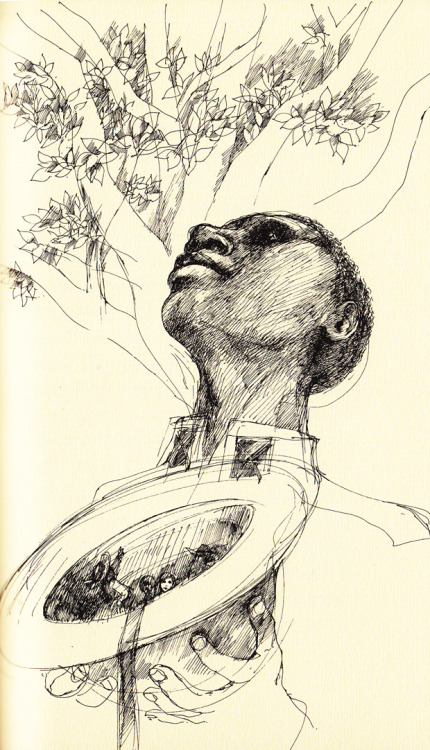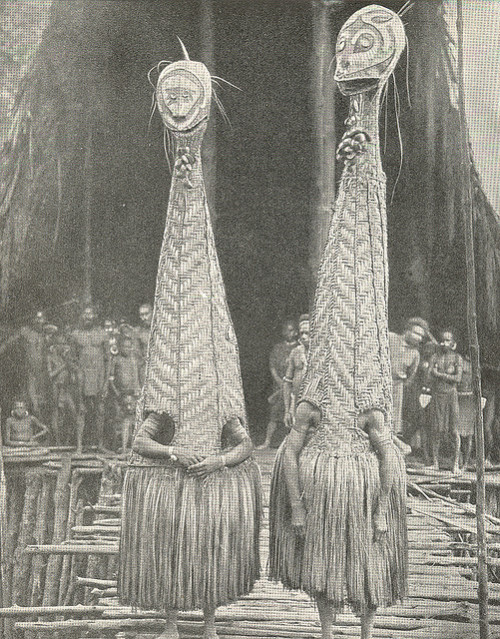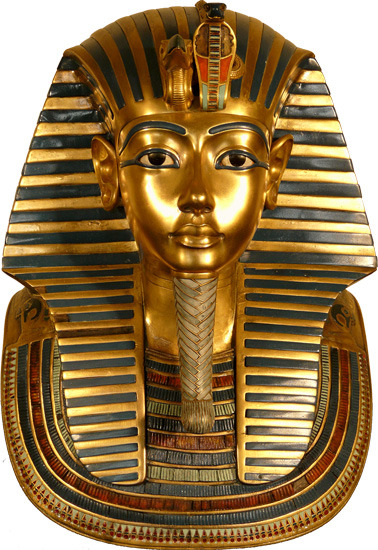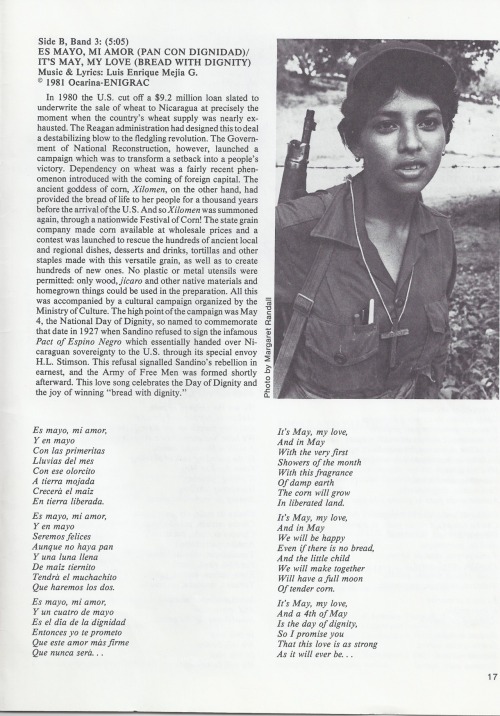
NYPD has global office: U.S. 'Terror' and Gun Laws Extended to Somalia

A map of the Horn of Africa nation of Somalia on the east coast of the continent. The state has undergone tremendous upheaval over the last three decades or more., a photo by Pan-African News Wire File Photos on Flickr.
U.S. ‘terror’ and gun laws extended to SomaliaSomalis face New York City trial
By Mick Kelly
December 28, 2012
fightbacknews.org
Brooklyn, NY - Three men from Somalia, Ali Yasin Ahmed, Madhi Hashi and Mohamed Yusuf, appeared in Federal District Court here, Dec. 21, on charges of violating U.S. “material support for terrorism” and gun laws. What makes this case different from the dozens of U.S. cases involving Somali men and women in Minnesota, California and other states is that there is no indication the men are U.S. residents or citizens, or that they have ever traveled to the U.S.
The conspiracy to provide “material support to a foreign terrorist organization” stems from their alleged membership in the Somali resistance organization, al Shabaab. Al Shabaab is an Islamic political movement that is fighting the U.S.-backed foreign intervention in Somalia.
The gun charge, according to a Dec. 21 press release form the New York Eastern District U.S. Attorney’s Office, involves the “unlawful use of machine guns” in Somalia.
The case against the three men rests on the dubious legal theory that U.S. laws can be applied anywhere in the world. The New York Times states, “Court documents show no connection between the alleged crimes and the United States.”
Two of the men, Mohamed Yusuf and Ali Yasin Ahmed, lived in Sweden for a time. Madhi Hashi was born in Somalia and grew up in England. The British newspaper, The Independent reported on Dec. 23 that when Hashi lived in London, he was one of a group of young people who said they were pressured by the UK intelligence agency, MI5, to become informants. After his return to Somalia, Hashi’s UK citizenship was revoked.
The Independent says of Hashi, “His family had no idea where he was for five months until he appeared in a New York court on Friday accused of terrorism. Last night, his British lawyer, Saghir Hussain, said: ‘This has all the hallmarks of rendition. It appears the withdrawal of citizenship and the kidnapping by the Americans may have been co-ordinated.’”
The U.S. Attorney’s Office claims, “In early August 2012, the defendants were apprehended in Africa by local authorities while on their way to Yemen.” On Oct. 18, 2012, a grand jury in the Eastern District of New York returned a sealed indictment against the defendants. On Nov. 14, 2012, the Federal Bureau of Investigation took custody of the defendants and brought them to the Eastern District of New York.”
The Independent quotes Hashi’s father, Mohamed, “’We are not some slaves who can be passed around from one owner to another,’ he said. ‘Why was our son sent to the U.S.? He has been a British citizen for 15 years but then his citizenship was taken away suddenly and now we find out that he's in New York? Our family had to find out this news from public news sources as no one has contacted us until now. We are very worried about his condition as we have no information. The U.S. have not given our son any rights – we don't know where he's being held, how to contact him or how he's being treated. It is shocking that something like this can be done to someone based on accusations and suspicion only.’”
Among those who announced the charges against the three men Dec. 21 was Raymond Kelly, the Commissioner of New York City Police Department. The NYPD has built a massive intelligence network that spys on Arabs and Muslims around the U.S. It is also setting up satellite offices in other countries.
Bass Reeves
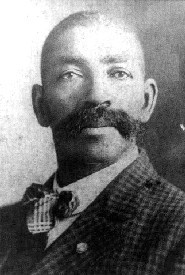
kenyaworkspace:
I stumbled upon the story of Bass Reeves at the Macon Branch of the Brooklyn Public Library a few years ago and have been sharing it with the children I’ve taught since that introduction. Although the story of Dangerfield Newby has been circulating as the ‘real-life Django’ and the romance of his story is appealing, it’s clear that most legends are a succotash of true events. In saying, Bass Reeves is certainly an important ingredient to the stew: “as one of the first African Americans (possibly the first) to receive a commission as a Deputy U.S. Marshal west of the Mississippi River.” He was a crack shot and lived to the ripe age of 72, escaping the hangman’s noose (or in the case of Mr. Newby, a bullet to the throat). The Legend of Bass Reeves: Being The True and Fiction Account of The Most Valiant Marshall in The West is available at your local library/ bookseller / online retailer. (Teach the babies, educate yourself.)
bim.
Today is Dec. 28: The Story of Tyisha Miller.

I always remember Tyisha Miller. Today I remember even more painfully because it is the anniversary of her embittering death. December 28, third day of the African American holiday of Kwanzaa. Before I tell you about a play I recently saw about her murder, let me give the back-story.
In the early morning hours of December 28, 1998, Tyisha Miller, a 19-year-old African American woman from Rubidoux, Riverside, California, had been driving with her 15-year-old friend late in her aunt’s Nissan Sentra when the car got a flat tire. A passing stranger helped them change the tyre, but the spare was flat, so the stranger led them to a filling station to inflate it. The tire would not hold air so Ms. Miller waited in the car while the man drove her friend home to get assistance from the family.
When relatives arrived they found Ms. Miller apparently comatose in the locked car, with the engine running and the radio on. She was shaking bodily and foaming at the mouth, and had a .380 semi-automatic pistol in her lap. Unable to wake her they called 9-1-1. Four Police officers arrived at the scene within minutes and, informed by family members of the presence of a gun in the car, approached the vehicle with guns drawn. After attempting for several minutes to get a response from Miller, the decision was made to force entry into the vehicle as Miller was in apparent need of immediate medical attention. As one of the officers was attempting to remove the gun, Miller is said to have sat up and grabbed the weapon, at which point the officers opened fire 23 times, hitting Ms. Miller with at least 12 bullets, including 4 in the head.
Back to the play, I recently had the honor of meeting the mastermind behind this play, Rickerby Hinds. He has been revolutionizing the landscape of Black performance with his hip-hop theater, a sub-genre of theater that uses beat-boxing, rapping as delivery of dramatic meaning on stage. As I sat in that theater watching this brilliant play called Dreamscape, I was hit by a bitter sense of familiarity with the play. I recognized the excellent portrayal of the daily micro-aggressions I endure as a Black man living in the US. I recognized the pain and the fear that flashes before my eyes everytime I get stopped by police for “fitting the description” of a burglar on the loose. And that description? Dark Skin.
Rickerby Hinds’ docu-dramatic play, Dreamscape is a stirring account of the cold murder of Tyisha Miller, a 19-year old African-American whom police officers shot when they found her comatose in her car. She was intoxicated – yes – but the bone-splitting bullets that rained upon her body remain a bitter, if unnecessary, reminder of racist police violence in the US. Using elements that an American audience would see as markers of Black culture in the US such as hip-hop, beat-boxing, ebonics etc., Rickerby Hinds cleverly weakens the power of the stereotype and makes way for multiple narratives of Blackness, or at least a Blackness definition that includes humanity. By that I mean that he does not deny that some of us Black people enjoy hip-hop for example but he shows what else we love – simply being human and being perceived as such without need to be spectacularized. There is an underlying tone of Negritude, of re-claiming racial charges, with which Hinds adapts the Tyisha Miller story.
As a Black man living in the US, I am an angry object of both White-against-Black racism, and America-against-foreigner racism. I am a fetishized token of diversity and Americans expect me to the embodiment of all things insultingly “cultural,” primitively “African” and so forth, completely erasing my individuality out of the picture. It is through my facelessness then that I recognize Tyisha’s. Before the law, she is just another Black body and that is why the said police officers can joke about her death, remarking laughingly that Kwanza having come early for her grieving family. To these laughing policemen, she is not someone’s daughter or sister, in the eyes of these keepers of law and order. She is just another one from that traumatized incomprehensible group that has hopped labels from Nigger to Negro to Black American to African-American in search of a name that cures the trauma of history only to find endless yearning for belonging.
Miller’s blood was spilt at the hand of police officers and as such the playwright uses the coroner’s report as his source material. In this way Hinds is able to show how draconic the American justice system is without ranting against it but rather holding up a mirror to the system itself. This literary device is well-employed to allow the audience to start its own conversation about the law and hopefully with the law. Another way that Hinds holds up the mirror – although this time to his audience – is by having a Black actor portray the police officers, none of whom were Black. Consumption of the Black body in American art and entertainment is of a body that can do too many things – like loudly sing, jump up and down as a minstrel, shout melodiously, contort like a snake, frighten with its gaze, seduce with its Otherness – but is never the face of the law, at least not in a way that calms anxious racists. Seeing the voice of the law embodied in Black skin therefore forces the audience to confront its prejudices therefore. You cannot deny that this is the legal report. But why is it strange to you that it is coming from a Black body, despite that body being American just like its blonde and blue-eyed compatriots? The audience gets to see its own prejudices and then hopefully that softens them to the adapted story of California’s Tyisha Miller.
Along the same vein of corporeal embodiment, Hinds exemplifies how adaptation can succeed transmedially. I am reminded of Josephine Baker who, although she is never included in the list of Negritude writes, did write with her body. She used her body as text and instrument in order to carve out new images of Black women’s power on stage and in returning the gaze of their spectator. In a similar manner, Hinds not only takes Tyisha’s emotions and last thoughts and puts them into the written word but also puts them into dance. Again, this being a hip-hop theater piece, I heard audience members’ airing their expectations of booty-popping before the show. But Hinds showed them a Black female body gliding through balletic movements with her clothes on which is a far cry from the Black female bodies that exist in hip-hop music only to writhe on truck-tops wearing only their underwear. The source material here, hip-hop music (especially for the beat-boxing parts), is re-territorialized in the process of adaptation in order to dismantle the single story of misogynist hip-hop, to dismantle the single story of the vixen Black dancer, to quietly and hopefully show that perhaps Tyisha’s life was more than her drug use or her skin.
Today is December 28. I am in California. I am Black.
Fwd: Black American Sign Language (ASL) Differences
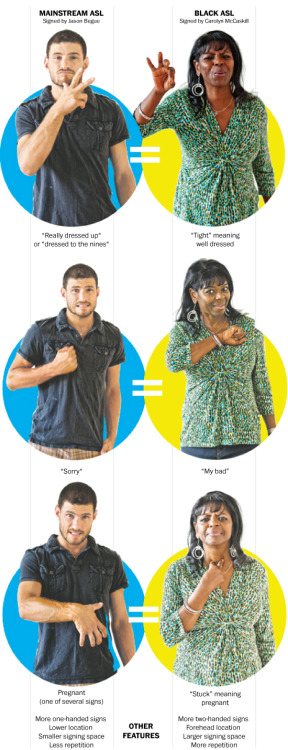
Reader Chris passes along an article about differences in American Sign Language usage between white and African-American signers. Researchers investigating what they call Black ASL found significant variations in signs, signing space, and facial cues. They explain:i’m pretty uncomfortable with the use of mainstream here, since it is othering.
Black ASL is not just a slang form of signing. Instead, think of the two signing systems as comparable to American and British English: similar but with differences that follow regular patterns and a lot of variation in individual usage.They hypothesize that these differences began in segregated learning environments, and continue to evolve in Black social spaces. The whole article is worth a read.
Thanks, Chris, and remember — you can submit Wonk-worthy links through our ask or via email!
the drug war bin a joke...
rollingstone | If you've ever been arrested on a drug charge, if you've ever spent even a day in jail for having a stem of marijuana in your pocket or "drug paraphernalia" in your gym bag, Assistant Attorney General and
longtime Bill Clinton pal Lanny Breuer has a message for you: Bite me.
Breuer this week signed off on a settlement deal with the British banking giant HSBC that is the ultimate insult to every ordinary person who's ever had his life altered by a narcotics charge. Despite the fact that HSBC admitted to laundering billions of dollars for Colombian and Mexican drug cartels (among others) and violating a host of important banking laws (from the Bank Secrecy Act to the Trading With the Enemy Act), Breuer and his Justice Department elected not to pursue criminal prosecutions of the bank, opting instead for a "record" financial settlement of $1.9 billion, which as one analyst noted is about five weeks of income for the bank.
The banks' laundering transactions were so brazen that the NSA probably could have spotted them from space. Breuer admitted that drug dealers would sometimes come to HSBC's Mexican branches and "deposit
hundreds of thousands of dollars in cash, in a single day, into a single account, using boxes designed to fit the precise dimensions of the teller windows."
hundreds of thousands of dollars in cash, in a single day, into a single account, using boxes designed to fit the precise dimensions of the teller windows."
This bears repeating: in order to more efficiently move as much illegal money as possible into the "legitimate" banking institution HSBC, drug dealers specifically designed boxes to fit through the bank's teller windows. Tony Montana's henchmen marching dufflebags of cash into the fictional "American City Bank" in Miami was actually more subtle than what the cartels were doing when they washed their cash through one of Britain's most storied financial institutions.
Zafar-wa-2-Itiopias [or "Buried Christian Empire Casts New Light on Early Islam"]

The commandment “Make yourself no graven image” has long been strictly followed in the Arab world. There are very few statues of the caliphs and ancient kings of the region. The pagan gods in the desert were usually worshipped in an “aniconic” way, that is, as beings without form.
Muhammad had a beard, but there are no portraits of him.
But now a narcissistic work of human self-portrayal has turned up in Yemen. It is a figure, chiseled in stone, which apparently stems from the era of the Prophet.
Paul Yule, an archaeologist from the southwestern German city of Heidelberg, has studied the relief, which is 1.70 meters (5’7”) tall, in Zafar, some 930 kilometers (581 miles) south of Mecca. It depicts a man with chains of jewelry, curls and spherical eyes. Yule dates the image to the time around 530 AD. Read more.
Babylon article talk dem. Were na 'Xchristos-ian-ababans" in dat time, hmmmph. ...but si idren 'go distance' ...muff read between the lines...link back (re-ligio) to what . What? What's the first verse ina Esther? Dem return agin time and time again ayaAWO: two ithiopias. TWO. Seen? Divinity in panel left? Ht hr seen in front of Roxbury MA Court House (JUDGMENT seen?) from Ceylon (andamans too) to Aden to Yemen to Addis (to sogolon djata too).
Tiyad yo. Tiyad yo.
Snow Crystal Symmetry
Scanning Electron Microscope Operator: Eric Erbe
Summary Authors: Bill Wergin; Jim Foster
The above images show the extraordinary symmetry of snow crystals even at high magnification. At top is a single stellar snow crystal with sector-like extensions that’s been magnified approximately 100 times (100X) using a Scanning Electron Microscope. One arm has been broken off during descent through the lower atmosphere. The second image shows a higher magnification view of two lower arms of the same snow crystal, and the third image shows the bottom-most arm now magnified over 900X. Note that the parallel groove and pit structures still exhibit a high degree of symmetry even at nearly 2,000X (bottom image). Images taken at the Scanning Electron Microscopy Lab of the Beltsville Agricultural Research Center in Maryland.
- Beltsville Agricultural Research Center, Maryland Coordinates: 39.037500, -76.874636
- Related Links
- Student Links
- Earth Observatory
In Bogalusa, Louisiana 1964

In Bogalusa, Louisiana 1964 civil-rights workers were surrounded by a horde of Ku Klux Klansmen. A Black man named Charles Sims saw that the chief of police was merely observing what could have been lots of bloodshed. Charles Sims walked over to the police chief and told him: “You better stop `em. Cause if you don’t, we’re gonna kill them all.” The top cop saw armed Black men staked out in protective formation around the building housing the civil-rights workers. There was no Klan violence that night. Sims later declared, “That night a brand-new Negro was born.” Cross burning ended suddenly in Jonesboro, Louisiana the night that a cross was set on fire in front of a clergyman’s house. The Deacons for Defense and Justice began busting shots at the KKK as the torch touched the cross. The Klan departed and never repeated that trick. In early 1965 Black students picketing Jonesboro high school were confronted by hostile police and fire trucks with hoses prepared to hose the black students until a car of 4 Deacons emerged and in view of the police, calmly loaded their shotguns. The police ordered the fire truck to withdraw. During a 1965 summer demonstration, white hecklers turned violent and threw a brick which struck a Black woman, Hattie Mae Hill. The white mob surrounded the car the Deacons were using to aid the terrified woman. As the white mob closed in on Deacon Henry Austin he fired point blank into the chest of Alton Crowe who was in the front of the mob. While Crowe survived, the fun of beating up on blacks died that afternoon in Bogalusa. No longer able to attack Black people without fear of retaliation from gun-wielding Deacons, the Klan began to lose its power-hold on the region. With the threat of violence greatly diminished the Deacons for Defense and Justice’s visibility declined. After 1968, the Deacons were inactive. The wife of one of the last surviving Deacon leaders says “I became very proud of Black men. They didn’t bow down and scratch their heads. They stood up like men.”
Police taking MLK to court
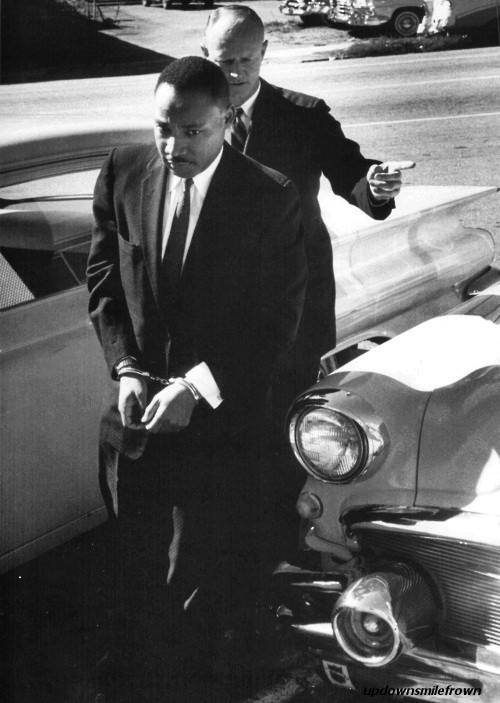
Police taking MLK to court for assuming leadership of the Montgomery bus boycott and of the burgeoning civil rights movement, Altanta, Georgia, 1960
by Don Uhrbrock
WHO We Are...
Who we are
ARE WE?I don't wish to be
Opportunity
Gone South ~
With an edict here
A redneck's lair
Uncle Tom
In the big house
Less a teenage rage
On a Facebook page
Like the war we wage
NO DOUBT
Killing brother man
With our trifling aim
In a prison built by louse
Darryl Abdu Omari :number1:a.k.a. 1poetsought ~ copyright 2011
Opportunity
Gone South ~
With an edict here
A redneck's lair
Uncle Tom
In the big house
Less a teenage rage
On a Facebook page
Like the war we wage
NO DOUBT
Killing brother man
With our trifling aim
In a prison built by louse
Darryl Abdu Omari :number1:a.k.a. 1poetsought ~ copyright 2011
Countee Cullen / "Heritage"

Heritage
by Countee Cullen
(SOURCE: My Soul's High Song: The Collected Writings of Countee Cullen / Anchor Books, 1991)
What is Africa to me:
Copper sun or scarlet sea,
Jungle star or jungle track,
Strong bronzed men, or regal black
Women from whose loins I sprang
When the birds of Eden sang?
One three centuries removed
From the scenes his fathers loved,
Spicy grove, cinnamon tree,
What is Africa to me?
So I lie, who all day long
Want no sound except the song
Sung by wild barbaric birds
Goading massive jungle herds,
Juggernauts of flesh that pass
Trampling tall defiant grass
Where young forest lovers lie,
Plighting troth beneath the sky.
So I lie, who always hear,
Though I cram against my ear
Both my thumbs, and keep them there,
Great drums throbbing through the air.
So I lie, whose fount of pride,
Dear distress, and joy allied,
Is my somber flesh and skin,
With the dark blood dammed within
Like great pulsing tides of wine
That, I fear, must burst the fine
Channels of the chafing net
Where they surge and foam and fret.
Africa? A book one thumbs
Listlessly, till slumber comes.
Unremembered are her bats
Circling through the night, her cats
Crouching in the river reeds,
Stalking gentle flesh that feeds
By the river brink; no more
Does the bugle-throated roar
Cry that monarch claws have leapt
From the scabbards where they slept.
Silver snakes that once a year
Doff the lovely coats you wear,
Seek no covert in your fear
Lest a mortal eye should see;
What’s your nakedness to me?
Here no leprous flowers rear
Fierce corollas in the air;
Here no bodies sleek and wet,
Dripping mingled rain and sweat,
Tread the savage measures of
Jungle boys and girls in love.
What is last year’s snow to me,
Last year's anything? The tree
Budding yearly must forget
How its past arose or set—
Bough and blossom, flower, fruit,
Even what shy bird with mute
Wonder at her travail there,
Meekly labored in its hair.
One three centuries removed
From the scenes his fathers loved,
Spice grove, cinnamon tree,
What is Africa to me?
So I lie, who find no peace
Night or day, no slight release
From the unremittant beat
Made by cruel padded feet
Walking through my body’s street.
Up and down they go, and back,
Treading out a jungle track.
So I lie, who never quite
Safely sleep from rain at night—
I can never rest at all
When the rain begins to fall;
Like a soul gone mad with pain
I must match its weird refrain;
Ever must I twist and squirm,
Writhing like a baited worm,
While its primal measures drip
Through my body, crying, “Strip!
Doff this new exuberance.
Come and dance the Lover’s Dance!”
In an old remembered way
Rain works on me night and day.
Quaint, outlandish heathen gods
Black men fashion out of rods,
Clay, and brittle bits of stone,
In a likeness like their own,
My conversion came high-priced;
I belong to Jesus Christ,
Preacher of humility;
Heathen gods are naught to me.
Father, Son, and Holy Ghost,
So I make an idle boast;
Jesus of the twice-turned cheek,
Lamb of God, although I speak
With my mouth thus, in my heart
Do I play a double part.
Ever at Thy glowing altar
Must my heart grow sick and falter,
Wishing He I served were black,
Thinking then it would not lack
Precedent of pain to guide it,
Let who would or might deride it;
Surely then this flesh would know
Yours had borne a kindred woe.
Lord, I fashion dark gods, too,
Daring even to give You
Dark despairing features where,
Crowned with dark rebellious hair,
Patience wavers just so much as
Mortal grief compels, while touches
Quick and hot, of anger, rise
To smitten cheek and weary eyes.
Lord, forgive me if my need
Sometimes shapes a human creed.
All day long and all night through,
One thing only must I do:
Quench my pride and cool my blood,
Lest I perish in the flood.
Lest a hidden ember set
Timber that I thought was wet
Burning like the dryest flax,
Melting like the merest wax,
Lest the grave restore its dead.
Not yet has my heart or head
In the least way realized
They and I are civilized.
Countee Cullen, “Heritage” from My Soul’s High Song: The Collected Writings of Countee Cullen. Copyrights held by the Amistad Research Center, Tulane University, administered by Thompson and Thompson, Brooklyn, NY.
"You start out in 1954 by saying “Nigger, nigger, nigger.”
“You start out in 1954 by saying “Nigger, nigger, nigger.” By 1968, you can’t say “nigger” — that hurts you. Backfires. So you say stuff like “forced busing,” “states’ rights,” and all that stuff. You’re getting so abstract now that you’re talking about cutting taxes, and all these things you’re talking about are totally economic things, and a byproduct of them is that blacks get hurt worse than whites.”
-Lee Atwater, a head republican strategist, in an anonymous interview in 1981. He is admitting that republicans use coded-language to appeal to the racists in their base. Because, as he always said, “people vote their fears.”
Lee, who would eventually become the head of the Republican National Committee, helped Ronald Reagan and George H.W. Bush win their Presidential elections by teaching them to use overtly-racist tactics.
When the N-word became taboo, Republicans began referring to black people in less-direct ways, with terms like “welfare queens.” They learned how to say the N-word, without saying the N-word.
Sadly, this still continues today. As seen in Newt Gingrich’s claim that Obama is a “food stamp President” and Rick Santorum’s assertion that he doesn’t “want to make black people’s lives better by giving them someone else’s money.”
(via thesoapboxschtick)
-Lee Atwater, a head republican strategist, in an anonymous interview in 1981. He is admitting that republicans use coded-language to appeal to the racists in their base. Because, as he always said, “people vote their fears.”
Lee, who would eventually become the head of the Republican National Committee, helped Ronald Reagan and George H.W. Bush win their Presidential elections by teaching them to use overtly-racist tactics.
When the N-word became taboo, Republicans began referring to black people in less-direct ways, with terms like “welfare queens.” They learned how to say the N-word, without saying the N-word.
Sadly, this still continues today. As seen in Newt Gingrich’s claim that Obama is a “food stamp President” and Rick Santorum’s assertion that he doesn’t “want to make black people’s lives better by giving them someone else’s money.”
(via thesoapboxschtick)
The African Diety Bes -From Central Africa To Kemet...
The African Diety Bes -From Central Africa To Kemet...: 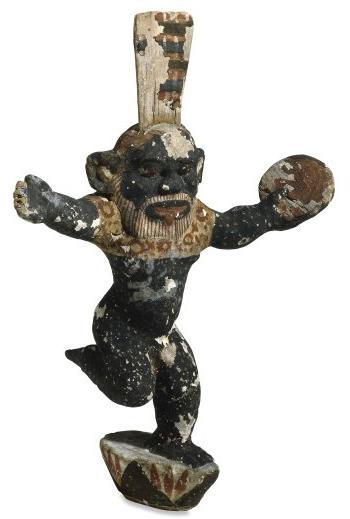
Bes From Thebes, Egypt 18th Dynasty
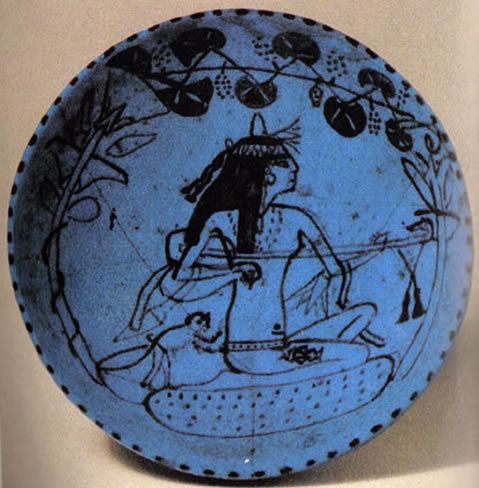
A musician with a tattoo of Bes
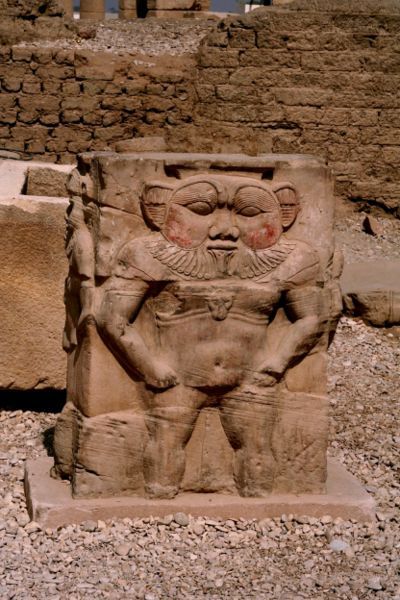
Bes relief at the Dendera Temple, Egypt
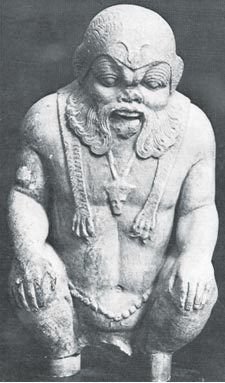
Bes Ibiza IBOSIM = The island of Bes.
nok-ind:

Bes From Thebes, Egypt 18th Dynasty

A musician with a tattoo of Bes

Bes relief at the Dendera Temple, Egypt

Bes Ibiza IBOSIM = The island of Bes.
nok-ind:
The African Diety Bes -From Central Africa To Kemet (Egypt).
The God Bes A guardian god. Bes was a foreign god, an import from the land of Nubia. He was jolly, fond of music, and dancing. He was a popular god who was adopted by the middle classes; he was considered a tutelary god of childbirth and, strangely enough, of cosmetics and female adornments. Bes chased away demons of the night and guarded men from dangerous animals. His image was carved on bedpost. He eventually became a protector of the dead and, amazingly, competed with even the refined and magnificent god Osiris for the attentions of men. He was originally the protective deity of the royal house of Egypt, but came to be a popular household deity throughout Egypt. Archeology Findings The oldest known fossil remains, according to Dr. Louis Leakey, were found in the Olduvai Gorge region in Kenya, Uganda and Tanzania. These first “small stature” people were known as the “Twa”, who worshipped the God Bes, a primitive human form of Horus I, being the earliest form of Ptah the God of Gods. The Twa, are modern humans or Homo sapiens sapiens. They are a diminutive Africoid people residing in the rain forests of Central Africa. Related groups live in South and Southeast Asia. We also find this same black God, Ptah, symbolized in the mystery system in Egypt. The Twa are said to have migrated the four thousand one hundred miles of the Nile river, establishing what was later to become the Egyptian civilization.
A Modern Theory of Language Evolution, by Carl J. Becker, 2004, p. 164 & 167: In Tanzania lie Lake Victoria, the Ngorongoro Crater and the Olduvai Gorge where the oldest known remains of the human species have been found. The north-south line of lakes, Albert, Ruranzige, Kivu, and Tanganyika, make the eastern edge of the Ituri Forest in Congo. The Efe Pygmies who live on the Ituri Forest called the Towering massif of Ruwenzori Baba Tiba, the Mountains of the Moon. In Efe theology the first man ascended to the heavens after serving as a benevolent governor of the primordial Pygmy nation. He then established residence on the moon where he still assists God by serving as the angel-of-the-moon. For tropical Black Africa the moon was, and still is, the favorite object of veneration, not the sun. Egyptian texts from around 2500 BC refer to the Pygmies as little men from the land of trees and spirits at the foot of the Mountains of the Moon. Egyptian king Nefrikare sent an expedition into central Africa and it returned with a dancing dwarf known as Akka. In the pyramid text of the sixth-dynasty monarch Pepi I it is declared that, “He who is between the thighs of Nut is the Pygmy who danceth like the god and who pleaseth the heart of the god before his great throne.” Nut was the goddess of heaven and the mother of Osiris. This Pygmy was called Bes. Page 167: We see, therefore, that it is physiology and genetics that tell us where our earliest ancestors came from; paleontology can only tell us where they went. Geneticist Douglas Wallace believes that Homo sapiens sapiens is descended from the ancestors of Baka Bambuke pygmies. Steven M. Stanley a paleontologist at Johns Hopkins supposes that hominids were forced out of the jungle environment by the cooler and drier climate of Earth by 2.5 millions years ago. Lucy’s group was probably part of this group. This would have been an Australopithecine version of the Twa Pygmies who live in the same general area around Lake Kivu on the eastern side of the Mountains of the Moon. The Twa have acclimated to life outside the Ituri Forest and are smiths, potters, and jack-of-all trades.
—————————————————————————————-
The Akka
That this race is an exceedingly ancient one is proved by the fact that Egyptologist Marriette Bey has discovered on a tomb of the ancient Empire of Egypt a figure of a dwarf with the name Akka inscribed by it.
Another Reference about the Twa people: Sako Ma: A Look at the Sacred Monkey Totem, By Matomah Alesha, Published 2004, Matam Press, pp. 35-36
Our oldest known human ancestor is a woman named Lucy. Her real name is unknown, but this is the name given to her by the archaeological team of Donald Johanson that uncovered her remains. The name Lucy is inspired by the Beetle’s song, Lucy in the Sky with Diamonds, which was heard while on an expedition. Lucy is dated to be, at least, 3.5 million years old. She is categorized as a species of Australopithecus afarensi. Her partial skeleton about the size of a chimpanzee was discovered in 1975. She has become known as one of the first Eves inhabiting ancient East Africa, although even still older fossils are being unearthed that push the date of the our original ancestor back even farther. Within the last 70 years, over 900 skeletons of prehominids are one hominid all dated at more then 1,000,000 years have been unearthed in Africa. ***** It is speculated that she was part of a clan, known variously in ancient and modern times as the Twa, Hottentot, Khoikhoi, San, Khmer, Bushmen, and Negrillos…The aboriginal peoples are found all over the world and form the basis of human culture…The aboriginal Twa are characterized by black to yellow skin, tightly curled hair (peppercorn), steatopygea (fat deposits in the rear-end) of some degree in women and men, full lips, elongated skull and a broad nose. They are short in stature and represent the mystical and mysterious short people documented in folklore and legend. The San, who are an extension of the Twa ancestors presently, live in the Kalahari Desert. The Twa descendants, however, live in rainforests and other remote areas around the world removed from modernization. This seed society gave birth to humanity both genetically and culturally.
On a side note: In Europe the Island Ibiza’s oldest name is Ibosim. Which translated from Punic language this word means “Island of Bes”.
Source: http://wysinger.homestead.com/bes.html
Ex-slave's Letter to Master
Ex-slave's Letter to Master:
Here is a fascinating view into the inhumanity of slavery. Jordan Anderson was a former slave who was freed from a Tennessee plantation by Union troops in 1864 and spent his remaining 40 years in Ohio. He lived quietly and likely would have been forgotten, if not for a remarkable letter to his former master published in a Cincinnati newspaper shortly after the Civil War.
Treasured as a social document, praised as a masterpiece of satire, Anderson's letter has been anthologized and published all over the world. Historians teach it, and the letter turns up occasionally on a blog or on Facebook. Humorist Andy Borowitz read the letter recently and called it, in an email to The Associated Press, "something Twain would have been proud to have written."
This letter is described in an article by Allen G. Breed and Hillel Italie in an Associated Press article available at http://goo.gl/erJjQ.
If you enjoyed this article, please share it with others. Tweet it, share it on Google+, Facebook or on your preferred social network.
Republishing of this article in newsletters, blogs, and elsewhere is allowed and encouraged, with a few minor restrictions. Details may be found at http://goo.gl/hoHH1.
Of course, if you haven’t done so already, you should join my email newsletter mailing list to stay current on my latest articles and announcements. You can also cancel at any time within seconds.
You also might like to leave a comment below.
Treasured as a social document, praised as a masterpiece of satire, Anderson's letter has been anthologized and published all over the world. Historians teach it, and the letter turns up occasionally on a blog or on Facebook. Humorist Andy Borowitz read the letter recently and called it, in an email to The Associated Press, "something Twain would have been proud to have written."
This letter is described in an article by Allen G. Breed and Hillel Italie in an Associated Press article available at http://goo.gl/erJjQ.
If you enjoyed this article, please share it with others. Tweet it, share it on Google+, Facebook or on your preferred social network.
Republishing of this article in newsletters, blogs, and elsewhere is allowed and encouraged, with a few minor restrictions. Details may be found at http://goo.gl/hoHH1.
Of course, if you haven’t done so already, you should join my email newsletter mailing list to stay current on my latest articles and announcements. You can also cancel at any time within seconds.
You also might like to leave a comment below.
I eat stereotypes like you for breakfast.
My friend Jeremiah sent me this picture last night via twitter, and in my head, I thought "I could make some stereotype biscuits for breakfast!" Which got me thinking. How many products with stereotypical imagery could I fit in one imaginary breakfast?
All of these products are readily available (though some are regional), and I decided not to include vintage products, because that would mean about 2 million more pictures. Ready?
Welcome, dear friends, to the first annual Stereotype Breakfast(TM)!


All of these products are readily available (though some are regional), and I decided not to include vintage products, because that would mean about 2 million more pictures. Ready?
Welcome, dear friends, to the first annual Stereotype Breakfast(TM)!
On our fictional menu: Cornbread with butter and honey, orange juice, toast, iced tea, and then some bonus snacks and drinks for the rest of the day. Who knew racial inequality could be so yummy?!
So our cornbread is ready to go, made with the Calumet baking powder and Indian Head Corn Meal pictured above. Served with some, of course, Land 'O Lakes butter:
and some Sue Bee Honey:
Close up on the logo, in case you can't see it (is she saying "how"? omggaasjfbkh, how ADORABLE!):
Then I think I'll have some toast. Hmmm, this one looks good! Oh wait, WHAT?

Ok, so maybe no toast. I'll just have some Orangina:
You know, I'd prefer it if my orange juice didn't wear a sacred headdress. Iced Tea, perhaps?
Guess not. Well, we could screw the whole breakfast idea and just have some ice cream. Who doesn't love ice cream?
Yeah. That didn't work out too well. Good thing I have my soda and snacks to hold me over for the rest of the day...
Cherikee Red. My favorite. With the authentic Cherokee regalia on the front and everything! And don't forget the Beef Jerky:
Something in here stinks. It must be all this racism. Good thing I've got my air freshener right here:
The sad thing is I could keep going and going...I'm sure you come across other products in your daily life as well (feel free to share in the comments). And this is just food. In isolation, each of these would seem like no big deal--these are the "good" stereotypical images. The "noble savage." No wild eyes or big noses, just headdresses and Indian maidens. But when taken as a collective, is it any wonder that most people in the world think of Native peoples as headdress-wearing Plains chiefs or buckskin-clad Indian women? I'm not saying there isn't stereotypical imagery of other racial/ethnic groups in branding, but the ubiquity of Native imagery is striking.
Many/most of these products have "historic" ties to the logo, but that's no excuse. If you look in the "about" pages of the companies, many of them mention the wish of the founders of the company to "honor" the local Native peoples. But, for example, sorry Umpqua Ice Cream, the Cow Creek Band of Umpqua Indians don't wear plains headdresses. It's 2012. I think it's time to critically examine the way that Native peoples are represented in branding and advertising. Why is this still socially acceptable?
Much like Indian mascots, these images are not "honoring," they serve to collapse hundreds of distinct nations and cultures into one stereotypical lump, and perpetuate stereotypes of Native peoples living like they did in the 1700's, rather than modern people who are shopping at the local Star Mart (without a headdress on). Truly, for many people, these are the only representations of American Indians that they see. Add on to that Indian mascots, hollywood stereotypes like Tonto and Twilight, and is it any wonder that Native peoples and issues continue to be marginalized and forgotten? How is a small child supposed to know that all Indians don't say "how" and wear feathered headdresses everyday, when every morning they are putting Land 'O Lakes butter and Sue Bee Honey on their squ*w bread?
I don't know about you, but this breakfast didn't sit too well with me. Turns out racial inequality isn't so yummy, it just makes my stomach hurt.
(Thanks Jeremiah!)
700 terabytes of data stored in one gram of dna
700 terabytes of data stored in one gram of dna:
Information Storage in DNA from Wyss Institute on Vimeo.
harvard | Using next-generation sequencing technology and a novel strategy to encode 1,000 times the largest data size previously achieved in DNA, a Harvard geneticist encodes his book in life’s language.
Although George Church’s next book doesn’t hit the shelves until Oct. 2, it has already passed an enviable benchmark: 70 billion copies—roughly triple the sum of the top 100 books of all time. And they fit on your thumbnail.
That’s because Church, the Robert Winthrop Professor of Genetics at Harvard Medical School and a founding core faculty member of the Wyss Institute for Biomedical Engineering at Harvard University, and his team encoded the book, Regenesis: How Synthetic Biology Will Reinvent Nature and Ourselves, in DNA, which they then read and copied.
Biology’s databank, DNA has long tantalized researchers with its potential as a storage medium: fantastically dense, stable, energy efficient and proven to work over a timespan of some 3.5 billion years. While not the first project to demonstrate the potential of DNA storage, Church’s team married next-generation sequencing technology with a novel strategy to encode 1,000 times the largest amount of data previously stored in DNA.
The team reports its results in the Aug. 17 issue of the journal Science.
The researchers used binary code to preserve the text, images and formatting of the book. While the scale is roughly what a 5 ¼-inch floppy disk once held, the density of the bits is nearly off the charts: 5.5 petabits, or 1 million gigabits, per cubic millimeter. “The information density and scale compare favorably with other experimental storage methods from biology and physics,” said Sri Kosuri, a senior scientist at the Wyss Institute and senior author on the paper. The team also included Yuan Gao, a former Wyss postdoc who is now an associate professor of biomedical engineering at Johns Hopkins University.
And where some experimental media—like quantum holography—require incredibly cold temperatures and tremendous energy, DNA is stable at room temperature. “You can drop it wherever you want, in the desert or your backyard, and it will be there 400,000 years later,” Church said.
Reading and writing in DNA is slower than in other media, however, which makes it better suited for archival storage of massive amounts of data, rather than for quick retrieval or data processing. “Imagine that you had really cheap video recorders everywhere,” Church said. “Just paint walls with video recorders. And for the most part they just record and no one ever goes to them. But if something really good or really bad happens you want to go and scrape the wall and see what you got. So something that’s molecular is so much more energy efficient and compact that you can consider applications that were impossible before.”
About four grams of DNA theoretically could store the digital data humankind creates in one year.


Information Storage in DNA from Wyss Institute on Vimeo.
harvard | Using next-generation sequencing technology and a novel strategy to encode 1,000 times the largest data size previously achieved in DNA, a Harvard geneticist encodes his book in life’s language.
Although George Church’s next book doesn’t hit the shelves until Oct. 2, it has already passed an enviable benchmark: 70 billion copies—roughly triple the sum of the top 100 books of all time. And they fit on your thumbnail.
That’s because Church, the Robert Winthrop Professor of Genetics at Harvard Medical School and a founding core faculty member of the Wyss Institute for Biomedical Engineering at Harvard University, and his team encoded the book, Regenesis: How Synthetic Biology Will Reinvent Nature and Ourselves, in DNA, which they then read and copied.
Biology’s databank, DNA has long tantalized researchers with its potential as a storage medium: fantastically dense, stable, energy efficient and proven to work over a timespan of some 3.5 billion years. While not the first project to demonstrate the potential of DNA storage, Church’s team married next-generation sequencing technology with a novel strategy to encode 1,000 times the largest amount of data previously stored in DNA.
The team reports its results in the Aug. 17 issue of the journal Science.
The researchers used binary code to preserve the text, images and formatting of the book. While the scale is roughly what a 5 ¼-inch floppy disk once held, the density of the bits is nearly off the charts: 5.5 petabits, or 1 million gigabits, per cubic millimeter. “The information density and scale compare favorably with other experimental storage methods from biology and physics,” said Sri Kosuri, a senior scientist at the Wyss Institute and senior author on the paper. The team also included Yuan Gao, a former Wyss postdoc who is now an associate professor of biomedical engineering at Johns Hopkins University.
And where some experimental media—like quantum holography—require incredibly cold temperatures and tremendous energy, DNA is stable at room temperature. “You can drop it wherever you want, in the desert or your backyard, and it will be there 400,000 years later,” Church said.
Reading and writing in DNA is slower than in other media, however, which makes it better suited for archival storage of massive amounts of data, rather than for quick retrieval or data processing. “Imagine that you had really cheap video recorders everywhere,” Church said. “Just paint walls with video recorders. And for the most part they just record and no one ever goes to them. But if something really good or really bad happens you want to go and scrape the wall and see what you got. So something that’s molecular is so much more energy efficient and compact that you can consider applications that were impossible before.”
About four grams of DNA theoretically could store the digital data humankind creates in one year.
Racialized Representations of Evolution
Paul M. sent along the image below, from an NPR story, commenting on the way skin color is used in the portrayal of evolution. There’s one obvious way to read this graphic: lighter-skinned people are more evolved (dare we say, “civilized”) than darker-skinned people. (The portrayal of fatness and its relevance to evolutionary fitness is another story in this particular graphic, as is the use of men and not women to represent humanity).

It seemed worthy to make a point of Paul’s observation, because this racialized presentation of evolution is really common. A search for the word on Google Images quickly turns up several more. In fact, almost every single illustration of evolution of this type, unless it’s in black and white, follows this pattern. (See also our post on representations of modern man.)





This is important stuff. It reinforces the idea that darker-skinned people are more animalistic than the lighter-skinned. It also normalizes light-skinned people as people and darker-skinned peoples as Black or Brown people, in the same way that we use the word “American” to mean White-American, but various hyphenated phrases (African-American, Asian-American, etc) to refer to everyone else. So, though this may seem like a trivial matter, the patterns add up to a consistent centering and applauding of Whiteness.
(View original at http://thesocietypages.org/socimages)


It seemed worthy to make a point of Paul’s observation, because this racialized presentation of evolution is really common. A search for the word on Google Images quickly turns up several more. In fact, almost every single illustration of evolution of this type, unless it’s in black and white, follows this pattern. (See also our post on representations of modern man.)





This is important stuff. It reinforces the idea that darker-skinned people are more animalistic than the lighter-skinned. It also normalizes light-skinned people as people and darker-skinned peoples as Black or Brown people, in the same way that we use the word “American” to mean White-American, but various hyphenated phrases (African-American, Asian-American, etc) to refer to everyone else. So, though this may seem like a trivial matter, the patterns add up to a consistent centering and applauding of Whiteness.
—————————
Lisa Wade is a professor of sociology at Occidental College. You can follow her on Twitter and Facebook.(View original at http://thesocietypages.org/socimages)
Subscribe to:
Comments (Atom)

